Tall Snatch: How To, Benefits & Alternatives
Author:
Unlock your full potential by engaging with our experts and community! Have questions about your fitness journey or looking for expert advice on weightlifting techniques? Don’t hesitate — leave a comment below and Oleksiy Torokhtiy will provide a personalized answer and insights to help you reach your goals.
Torokhtiy is reader-supported. Some links are affiliate links, and we may earn a commission at no extra cost to you. See our disclosure page for details.
Tall snatch just sounds intriguing, right? Right off the bat, you know you’re in for something different and fun.
It’s a very dynamic exercise that can boost your speed and coordination and you’ll get a unique kind of challenge with it. It’s an exercise that can spice up your routine and it’s not just for lifters; you’ll see everyone can benefit from it.
Grab a bar and let’s learn everything there is to know about the tall snatch!
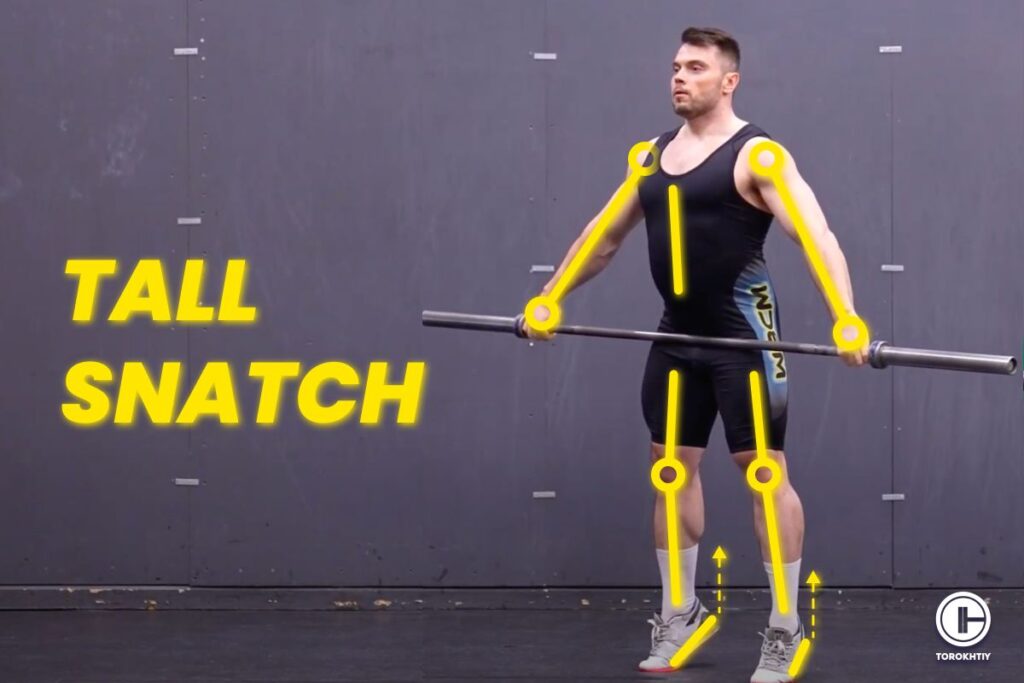
What Is the Tall Snatch?
Since you probably just want to get familiar with it, we’ll keep this part short and sweet.
The tall snatch is a lifting exercise that’s meant to improve the speed and aggressiveness of your turnover during snatch movements. You start with the bar at hip crease, using only the explosive power of your ankles and a quick arm pull to drive the bar overhead.
Unlike the traditional snatch that starts from a lower position and can involve heavier weights, the tall snatch focuses on perfecting technique with lighter loads, typically around 30% of your maximum.
It’s ideal for Olympic weightlifters and cross-training athletes who want to refine their snatch technique, but it may not be as beneficial for general fitness enthusiasts because of its specificity.
How to Do the Tall Snatch?
1. Setup
Your feet should be hip-width apart with the weight distributed evenly across your feet. Use a wide grip on a barbell and place the barbell in your hip crease and be sure you don’t hit your pubic bone. Your arms should be totally extended with elbows pointing out.
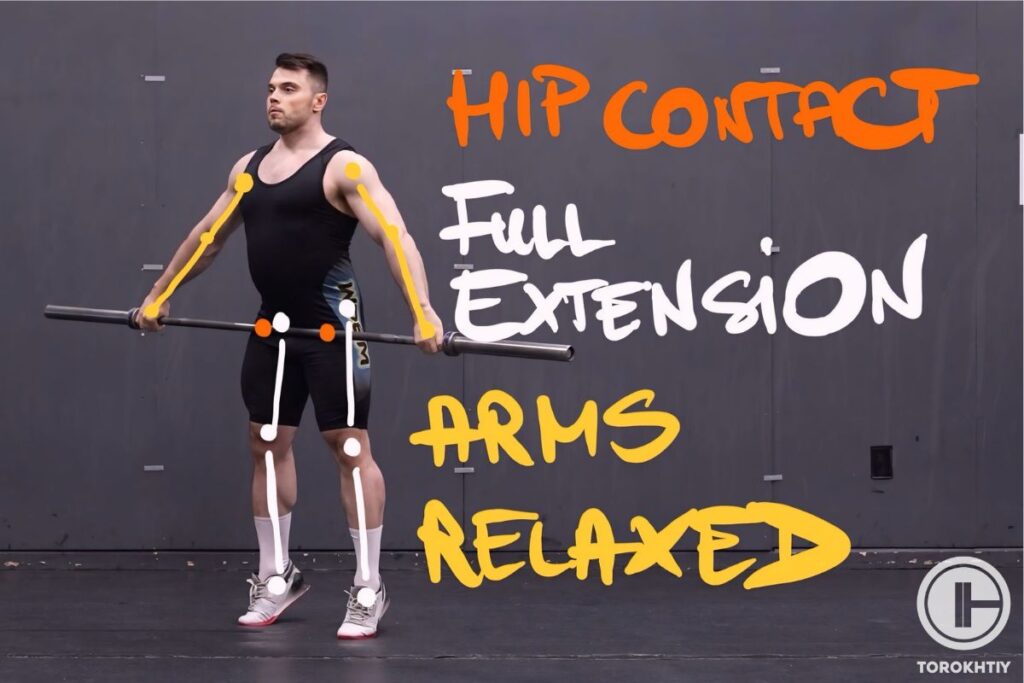
2. Power Position and Turnover
The bar should be in the power position, resting in your hip crease. Engage your core, toughen your back and lift the bar slightly. Keep it close to your body throughout the movement.
Drive the lift by explosively extending your ankles, rising onto the balls of your feet. Quickly shrug your shoulders to add upward pull to add some momentum and focus on a fast, aggressive turnover, and pull yourself under the bar into a squat. It’s all about that fast and aggressive drop.
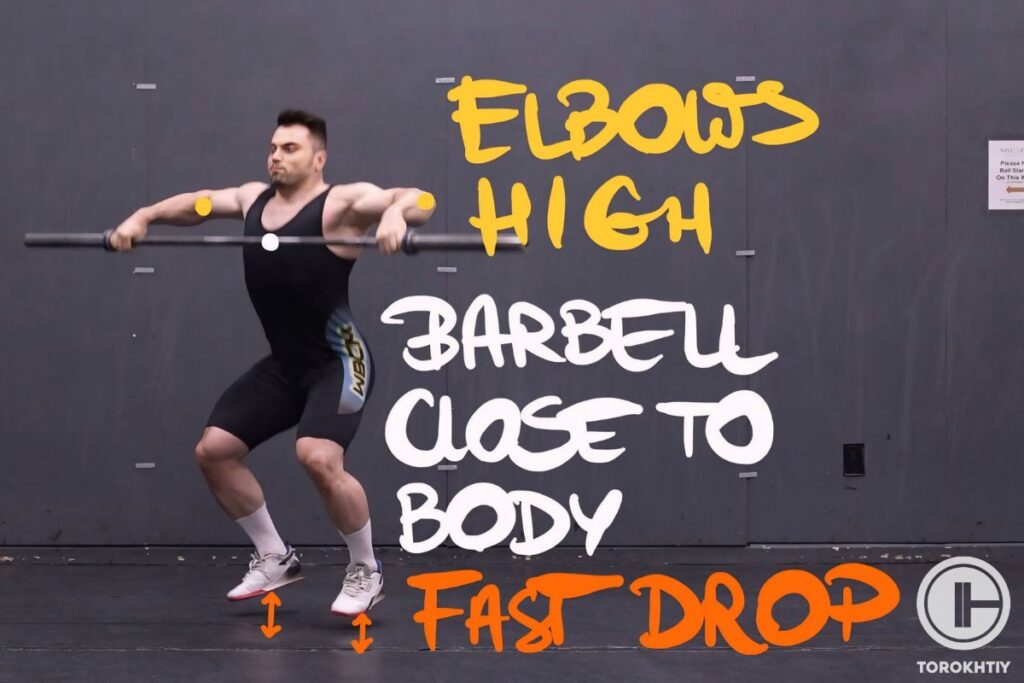
3. Catch
Once you’ve dropped under the bar and into a squat, immediately extend your arms overhead to stabilize and secure the bar.
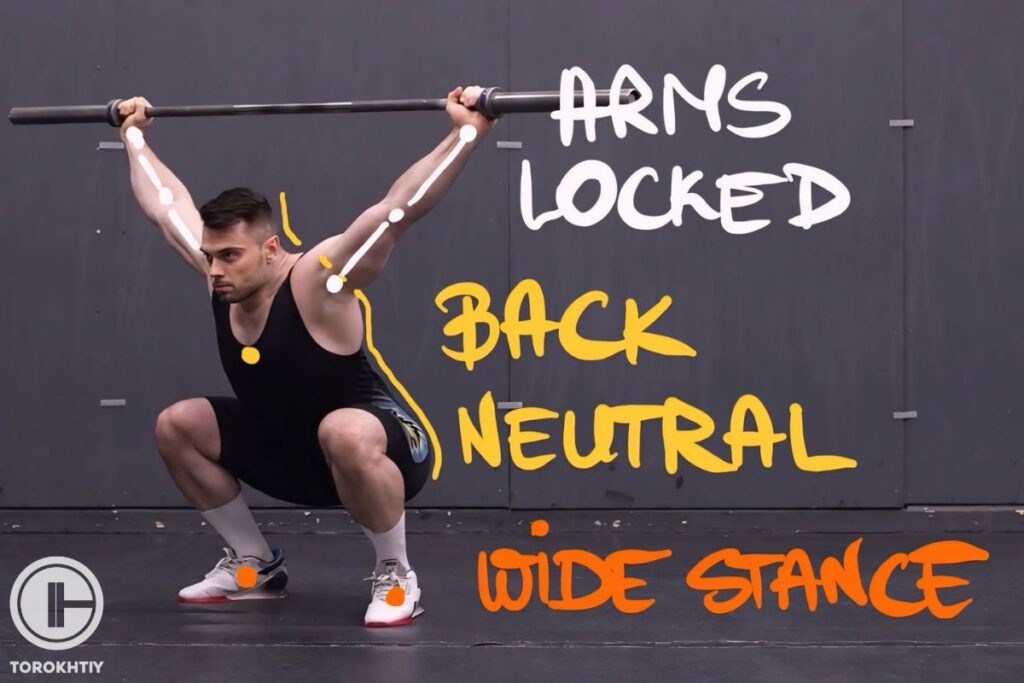
4. Recovery
Make sure your feet are firmly planted on the ground and your body is stable in a squat. Keep the bar balanced over your midline, directly above your shoulders and hips.
Drive through your feet and stand up from the squat. Keep your arms locked and the barbell steady overhead as you get up.
Save it for easy access!
Bookmark this page now to access the program and instructional videos anytime, anywhere.
Stop wasting time searching during your gym sessions.
An Easy-to-Follow Tall Snatch Program
| Level | Reps | Sets | Frequency |
|---|---|---|---|
| Beginner | 3 | 3 | 1-2 times per week |
| Intermediate | 1-3 | 3-5 | 2-3 times per week |
| Advanced | 1-3 | 1-5 | as many as needed |
Beginner
- Reps: 3
- Sets: 3 per session
- Frequency: 1-2 times per week
- Progression: Your focus is not on lifting heavy weights. Instead, you’ll use either an empty barbell or only a stick to get the form down. After that, you can start adding weights in 5-10 lbs increments.
Intermediate
- Reps: 1-3
- Sets: 3-5 per session
- Frequency: 2-3 times per week
- Progression: Add more weights gradually and focus on explosiveness and speed during the lift.
Advanced
- Reps: 1-3
- Sets: 1–5 per session
- Frequency: as many as needed
- Progression: Increase the weight gradually, but make sure it doesn’t exceed approximately 35% of your snatch 1RM unless you do it perfectly. Also, think about incorporating the tall snatch into various Olympic lifting complexes to develop coordination and technique even further.
Follow us!

Free!
Get a 2-week Weightlifting Program as a bonus for the subscription to kickstart your training plan!

Free!
3 Common Tall Snatch Mistakes
❌ Improper Starting Position
This goes back to the importance of form we discussed previously; if you start off with a bar too low or too high, you’ll throw the whole lift off. Plus, it won’t be as efficient if your form is not good.
The bar should be in the exact position as with your normal snatch power position. If it’s just an inch too low, you’ll hit your pubic bone and that’s going to be super painful.
❌ Lack of Aggressiveness
You need quick, powerful hip extension to be able to do the tall snatch. If that doesn’t happen, the lift will be sluggish and blah.
❌ Inconsistent Bar Path
The bar needs to move in a straight, vertical path. Don’t have it swinging in front and don’t pull it too close to your body or you’ll disrupt the lift.
3 Benefits of Tall Snatch
✅ Better Drop Speed and Technique
The tall snatch primarily benefits drop speed and technique because of its focus on the rapid drop under the bar combined with an active arm pull.
This exercise focuses on the speed of the turnover and the precision of catching the bar in the overhead position, which helps improve your ability to stabilize the bar quickly and efficiently during the snatch.
Tips From the Champ
In my experience, the tall snatch is one of the best drills for refining turnover speed & quality. Focus on pulling yourself under the bar quickly – this drill will make your full snatch smoother and more precise.
Olympic Weightlifting Champion
✅ Improved Coordination
Several of your muscle groups need to be coordinated to make the tall snatch happen, so over time, this exercise will improve neuromuscular coordination.
✅ Improved Elements of the Snatch
The tall snatch can refine specific elements of your snatch technique. With the focus on the quick transition from extension to receiving the bar, it will improve your technique, timing and coordination, which is important for a smooth, efficient snatch.
Tall Snatch Variation
Tall Muscle Snatch
It’s the same as the tall snatch, except you lift the bar without dropping into a squat. This variation focuses on upper body and shoulder movement .
8 Tall Snatch Alternatives
1. Snatch Balance
In the snatch balance, you lift the barbell from your shoulders to overhead using a slight dip and drive from the legs. Your legs should be hip-wide apart (regular stance). The barbell should be rested on your back (behind your neck/head).
Do an overhead squat grip on the bar. Your torso dips straight down during the movement, and your hips and legs should extend rapidly. Press under so that the bar does not move up significantly, while your feet move to a shoulder-width stance. The barbell will be received at the bottom of an overhead squat.
You complete the move at full hip/knee/arm extension. Go back to the standing position while keeping the barbell overhead the entire time. Snatch balance focuses on shoulder and upper body strength, but it also incorporates some lower body power.
2. Dumbbell Snatch
If you’re dealing with muscle imbalances, then this exercise will be great because it can address them. Muscle imbalances can cause injuries, so make sure to handle them promptly.
3. Hang Power Snatch
This one combines elements of the hang snatch and power snatch. It starts from the hang position and catches the bar in a partial squat. It focuses on explosive power and the ability to quickly get under the bar.
4. Hang Snatch High Pull
Start with the bar at knee level and maintain strong posture as you explosively extend your hips and knees. As the bar goes up, lead with your elbows to pull it to chest height.
Hang Snatch High Pull is an excellent way to improve your pull strength and the transition phase of the snatch.
5. Upright Row
Stand with your feet shoulder-width apart and hold a barbell with an overhand grip. Lift it straight up towards your chin, leading with your elbows, and keep it close to your body.
Upright rows will improve the stability in your shoulders and build muscles that are involved in the pulling phase of the snatch.
6. Tall Clean and Press
This is a functional exercise that helps develop power and coordination throughout the entire body.
Start with the bar at your hips, do a slight upward shrug, and then quickly drop under the bar. Catch it on your shoulders in a partial squat. Stand up and finish by pressing it overhead.
Who Should Do the Tall Snatch?
1. Weightlifters
If you’re a weightlifter who’s looking to improve their snatch technique or just lifting performance in general, give the tall snatch a go. It will refine the turnover phase .
2. Fitness Competitors
Those that are preparing for fitness competitions that include components of Olympic lifting should practice the tall snatch to perfect their technique and build speed.
Muscles Worked by the Tall Snatch
It involves your entire body, but it specifically improves speed, coordination, and mobility. The main focus is on the controlled drop under the bar, with your arms actively pulling and your legs preparing to receive the bar in the drop.
The core keeps you stable throughout the entire movement, the back plays a big role in supporting and stabilizing your torso, and your forearms help control the barbell.
Conclusion
Well, we’ve covered everything – how to do it, what mistakes to be wary of, how to keep progressing, some variations and alternatives… There’s nothing left to say about the tall snatch, you have it all!
Regardless of your fitness level, keep pushing through the discomfort and frustrations that come (especially at the beginning) because in the end, you’ll get some incredible benefits out of it. Be consistent, but allow yourself a day or two to just chill on the couch because your muscles need that downtime to recover.
What’s your take on this? We’d love to hear anything you have to add! Have you tried the tall snatch or any of the variations, what are some challenges you’ve had to overcome and how do you stay motivated? Have we missed any of the important points?
Let’s keep talking in the comment section!
References:
- Becks Shepherd “Why are rest days important?” LiveScience, https://www.livescience.com/why-are-rest-days-important (accessed June 20th, 2024)
- Mayo Clinic Staff, “Weight training: Do’s and don’ts of proper technique,” Mayo Clinic, https://www.mayoclinic.org/healthy-lifestyle/fitness/in-depth/weight-training/art-20045842 (accessed June 20th, 2024)
- Stephan Geisler, Tim Havers, Eduard Isenmann, Jonas Schulze, Leonie K. Lourens, Jannik Nowak, Steffen Held, G. Gregory Haff, “Effects of Expertise on Muscle Activity during the Hang Power Clean and Hang Power Snatch Compared to Snatch and Clean Pulls – An Explorative Analysis,” Journal of Sports Science and Medicine 22 (2023): 778-789.
- Venkat S. R. “What Are Muscle Imbalances?” WebMD, https://www.webmd.com/fitness-exercise/what-are-muscle-imbalances (accessed June 20th, 2024)
- Photos by Torokhtiy Media Team.
Why Trust Us?
With over 20 years in Olympic weightlifting, strength training, nutrition coaching, and general fitness our team does its best to provide the audience with ultimate support and meet the needs and requirements of advanced athletes and professional lifters, as well as people who strive to open new opportunities and develop their physical capabilities with us.
By trusting the recommendations of our certified experts in coaching, nutrition, and sports training programming, as well as scientific consultants, and physiotherapists, we provide you with thorough, well-considered, and scientifically proven content. All the information given in the articles concerning workout programming, separate exercises, and athletic performance, in general, is based on verified data.
The product testing process is described in more detail here.
Author: Oleksiy Torokhtiy
Olympic Weightlifting Champion
Best Results: Snatch – 200 kg,
C&J – 240 kg
Oleksiy Torokhtiy is a professional athlete boasting 20 years of experience in Olympic weightlifting. With multiple European and World titles under his belt, he has showcased his prowess in two Olympic Games (Beijing 2008 and London 2012). Upon concluding his illustrious career, Oleksiy dedicated himself to coaching. By 2022, he had conducted over 200 weightlifting seminars worldwide. He is the visionary behind an international sportswear and accessories brand known for its motto, “Warm Body Cold Mind.” Additionally, he is an esteemed author and the creator of a series of training programs and eBooks.




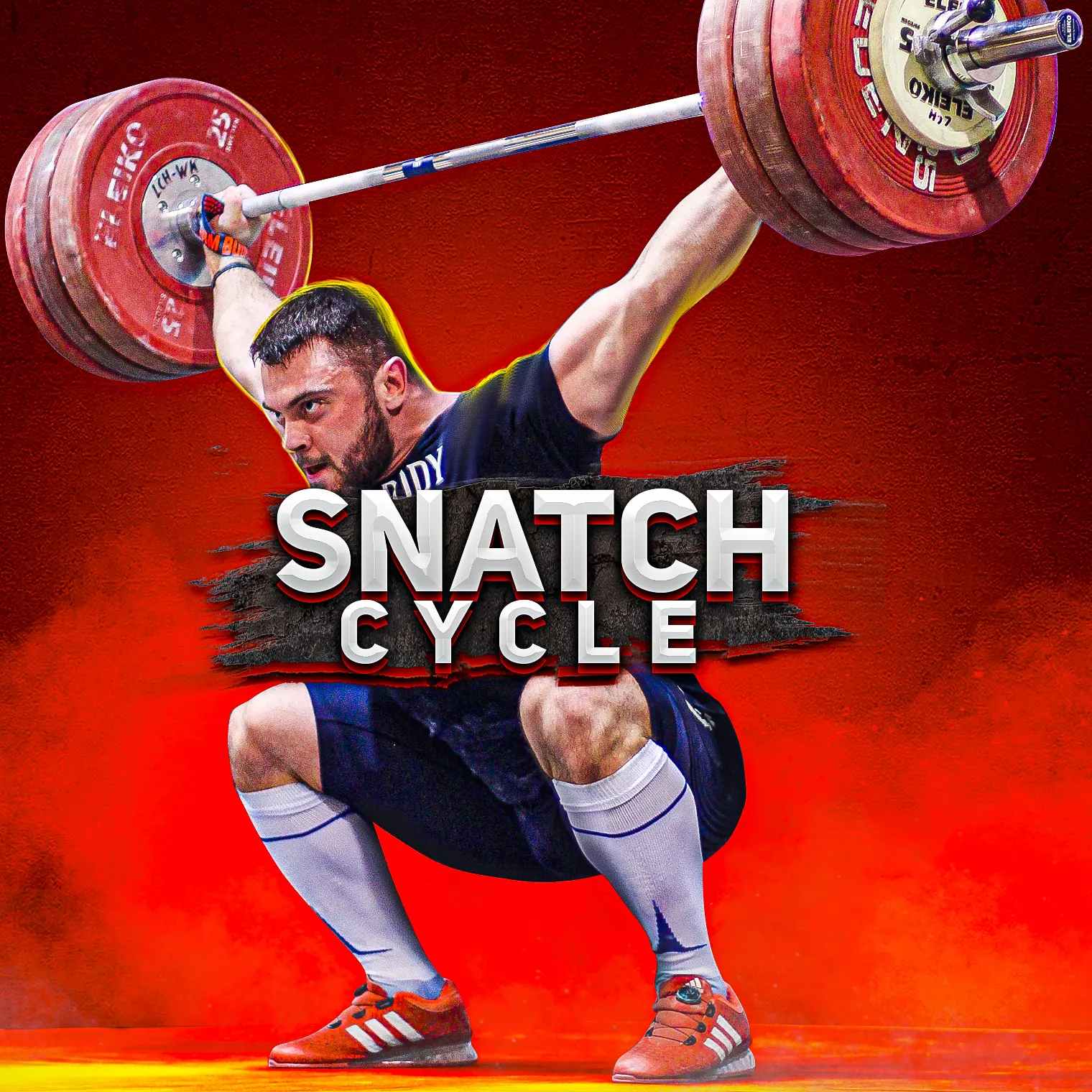
Still have questions after reading our article? Unlock your full potential by engaging with our experts and community! Don’t hesitate — leave a comment below and Oleksiy Torokhtiy will provide a personalized answer and insights to help you reach your goals.